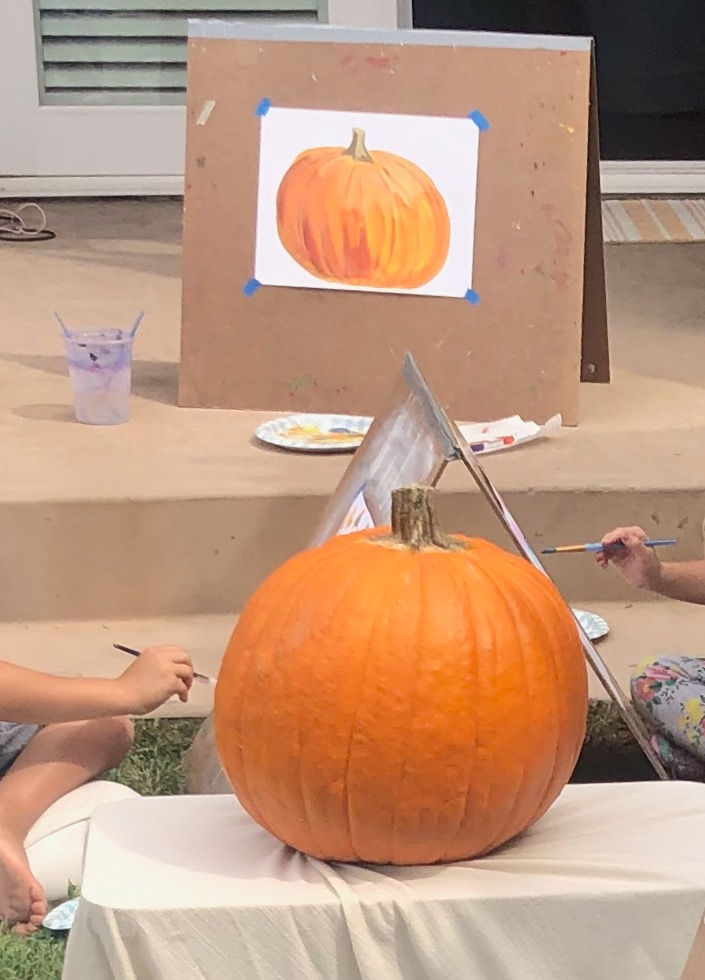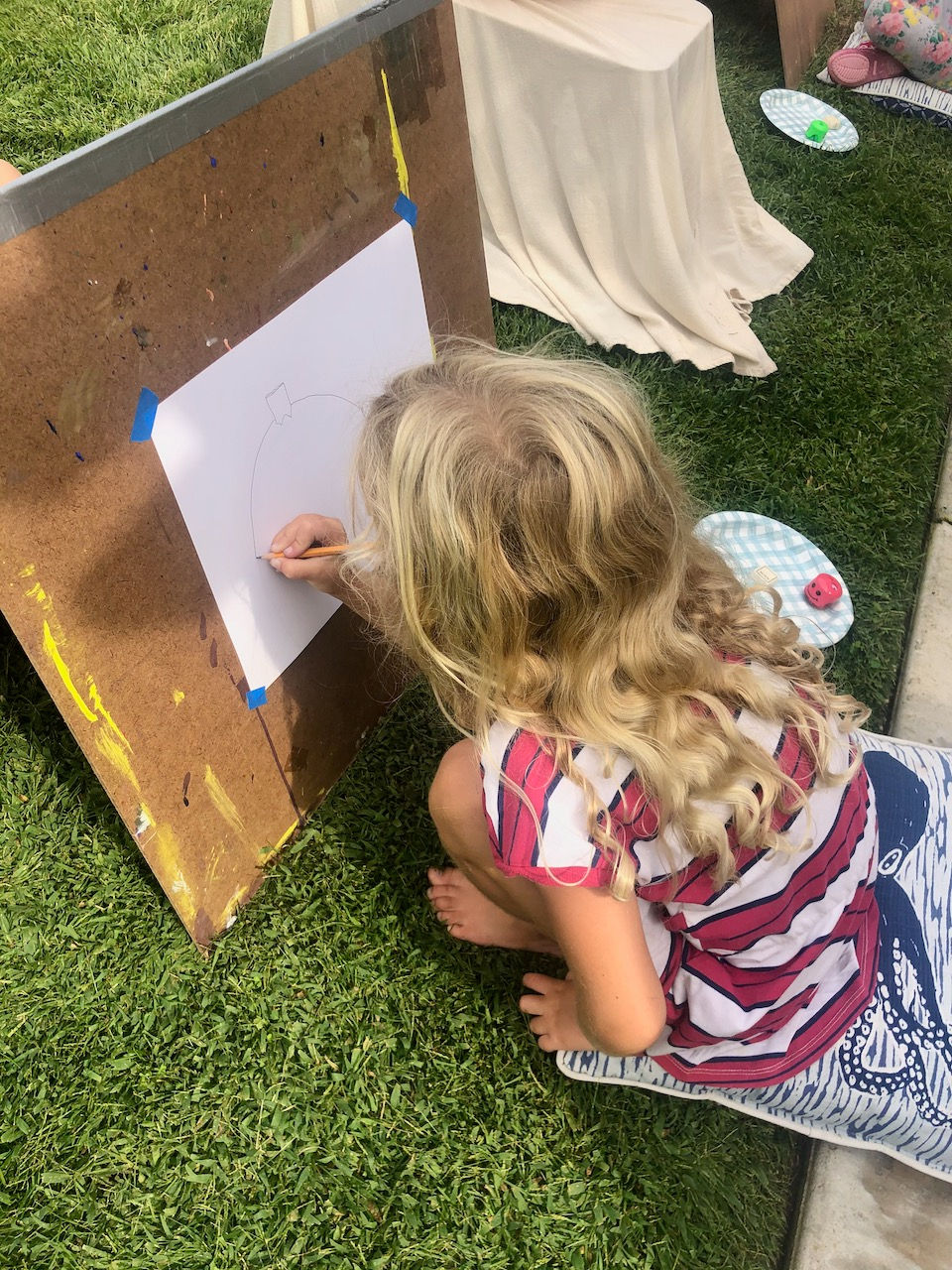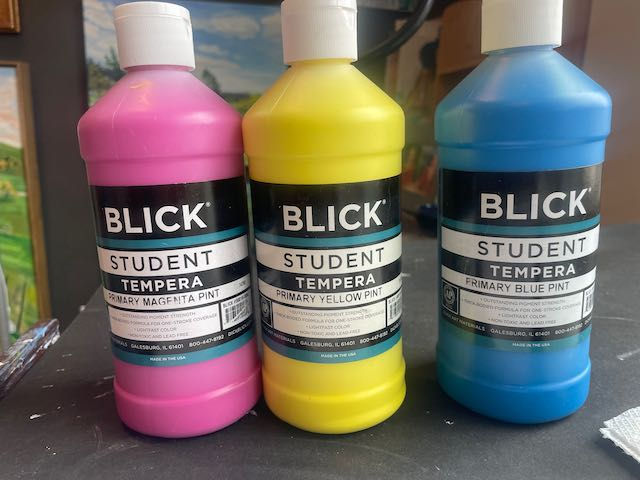Paint a Pumpkin, a fun observational drawing activity for kids!
- ArtfulMommy

- Oct 6, 2020
- 4 min read
Updated: Jul 19, 2023
October is here and I've been thinking about festive art projects we could do in our first grade pod. Observational drawing is one of the building blocks to being a great artist and I've been wanting to incorporate more of it into our days. Today I set out one huge pumpkin and had the kids paint it, and I've never seen them more focused!

The best part of observational drawing is it requires very little in terms of supplies and set up. As long as you have paint, brushes and paper you can basically put anything simple in front of children and ask them to draw it. Pumpkins are a simple, fairly easy object for kids of any age to draw.
Drawing from observation helps artists to see and study shapes and color. It helps to train our brains to be able to take in 3-dimensional information, process it and send it back out again onto a 2-dimensional surface. As a teacher there are lots of things you can teach a child through observational drawing. First you can teach them to see the outline or shape of an object (draw it). Then you can teach them to see details (more drawing). And the most fun part, is teaching them to mix their colors adding light and shadow to the form (painting).

Materials: Lawn easels (optional), a pumpkin, red, blue, yellow and white paint (or magenta, yellow and turquoise), paper, brushes of various size, paper towels, and plastic water containers.
Set out the lawn easels with a piece of paper taped to each side and a pencil and eraser next to each child. Place the pumpkin somewhere between them so they all can get a good view. A big pumpkin is best, because kids tend to paint things the size they are and you want this to fill up the page. Don't pass out the paint until after you show them how to draw it.
Ask them to look at the pumpkin and tell you the shape of the pumpkin. Tell them to put their pencil down and draw the pumpkin with only their finger on the paper starting at the stem. This will help them visualize it and fit it to their page. Next draw your demo pumpkin nice and big on your paper. Ask them if they think they should draw dark or light. Light pressure is best, so that they can erase mistakes easily and also so it doesn't show through the paint too much. Ask them what they see inside the pumpkin. Lines. Draw the lines starting with the one in the middle which is mostly straight up and down, the ones to the left curve the direction of the letter C and the ones to the right curve the same direction as the curves in number 3. Some kids will get this right and some won't, don't worry about what they actually draw. Twenty five straight lines are fine, this might be the first time they ever drew something from observation.

It is really important when kids are learning to draw not to over-correct them. Drawing is like spelling. At this age you just want them drawing, as they get older they will start to see their mistakes and change them on their own. If they ask for help tell them to be a brave artist and try their best!
After they have completed their drawings, talk about color. Introduce the idea of the three primary colors. The three primary colors are generally known as red, yellow and blue. You cannot create primary colors through mixing, instead you can use them to mix all the colors in the rainbow. Think about your printer cartridge, it has Cyan, Magenta and Yellow, and with these three colors you can print any color. When purchasing tempera paint I recommend buying Turquoise, Magenta and Yellow, you will get a more accurate color mixing than the standard Red, Yellow and Blue. You will also need white for tints. I do not give kids black. If you give them black they will put a drop in and it will overpower their colors and make them muddy. Instead teach them to mix a dark brown by mixing Red (magenta), Yellow and Blue (turquoise). When I paint with oils I never use black paint, I don't even own black paint. Instead I find ways to mix a color very close to black with my primaries. After all, black actually isn't a color we see much in nature.

Ask them if they know what colors make orange, then show them how to mix it (red and yellow). Ask them where they see the light hitting the pumpkin. Add white to show how to create a lighter tint of orange. Ask them where they see shadows. Add a slight drop of blue to create a darker shade of orange. Ask them what colors they need to mix green. And what colors they need to make sky color. At this point the kids will be begging you to start painting, so let them go. Tell them they can paint whatever they want in the background. As they are busy painting you can keep talking to them about mixing as you work on your own painting.
Tell them that they are done when they say they are done. Offer them lots of positive encouragement along the way.

Observational drawing and color mixing are often overlooked, yet are two of the most important building blocks in art. Think about all the things you could have them draw from observation. Some things that come to my mind are: fruit, flowers, a stuffy or favorite toy, even a self-portrait or a portrait of a friend. I hope this gives you lots of ideas for drawing from observation! The best part is students of all ages will love doing it!
If you enjoyed this post, subscribe to my blog to get all my latest project ideas!





Painting pumpkins is a delightful and educational activity for children that encourages creativity and enhances fine motor skills. Here’s how you can make the most of this activity:
Encourage Observation: Teach kids to focus on the shape, colors, and details of the pumpkin.
Use of Colors: Let children experiment with different colors for their pumpkin design, fostering creativity.
Development of Fine Motor Skills: Holding brushes and applying paint helps improve hand-eye coordination.
Educational Aspect: This activity offers a great opportunity to teach kids about pumpkins and autumn.
For more creative ideas to support your child’s learning, seek expert assignment help that can guide you through engaging educational activities. Whether you need assistance with assignments or creative project ideas, MyAssignmentHelp is here…
Writing a compelling college essay can be a transformative step in your academic journey. It requires creativity, clarity, and a deep understanding of the expectations of admission committees. Crafting an essay that truly reflects your personality and aspirations often takes time and effort, which can be challenging amidst a busy schedule. That’s where the right guidance makes all the difference.
At MyAssignmentHelp.com, our college essay writing service is designed to support students in creating essays that stand out. With expert writers who understand the nuances of academic writing, we ensure your essay is not just well-written but also tailored to showcase your strengths and individuality. Whether it’s brainstorming ideas, polishing a draft, or starting from scratch, we’re here to help you…
Paint a Pumpkin sounds like a fantastic and creative activity for kids! It encourages observational skills while allowing them to express their creativity. Plus, working with colors can be a fun way to explore art. If you’re looking for more engaging projects or need assistance with assignments, don’t hesitate to check out MyAssignmentHelp for support in Sydney!
CBSE Class 12 exams are usually held in March, making it essential for teachers and students to complete the syllabus beforehand. Once the syllabus is covered, utilizing CBSE Sample Papers for Class 12 from the digital platform of SelfStudys can be highly beneficial. These papers offer a variety of questions, helping you identify your weak areas so you can focus on improving them. You can also learn about the topics that are frequently asked in the exam and master them with the help of these sample papers. Moreover, every question in the sample paper is accompanied by solutions and detailed explanations that help to increase your conceptual understanding.
Paint a Pumpkin: A Fun Observational Drawing Activity for Kids!" is a fantastic way to engage children in art through a hands-on, creative exercise. The activity not only encourages kids to develop their observational skills but also sparks their creativity in a fun and festive way. This approach is reminiscent of how assignment help in Sydney can support students by providing structured, insightful guidance tailored to their needs. Similarly, MyAssignmentHelp offers expert assistance to ensure assignments are well-crafted and meet academic standards. Just as these resources enhance the learning experience, the pumpkin painting activity enriches children's artistic abilities and fosters a love for drawing.